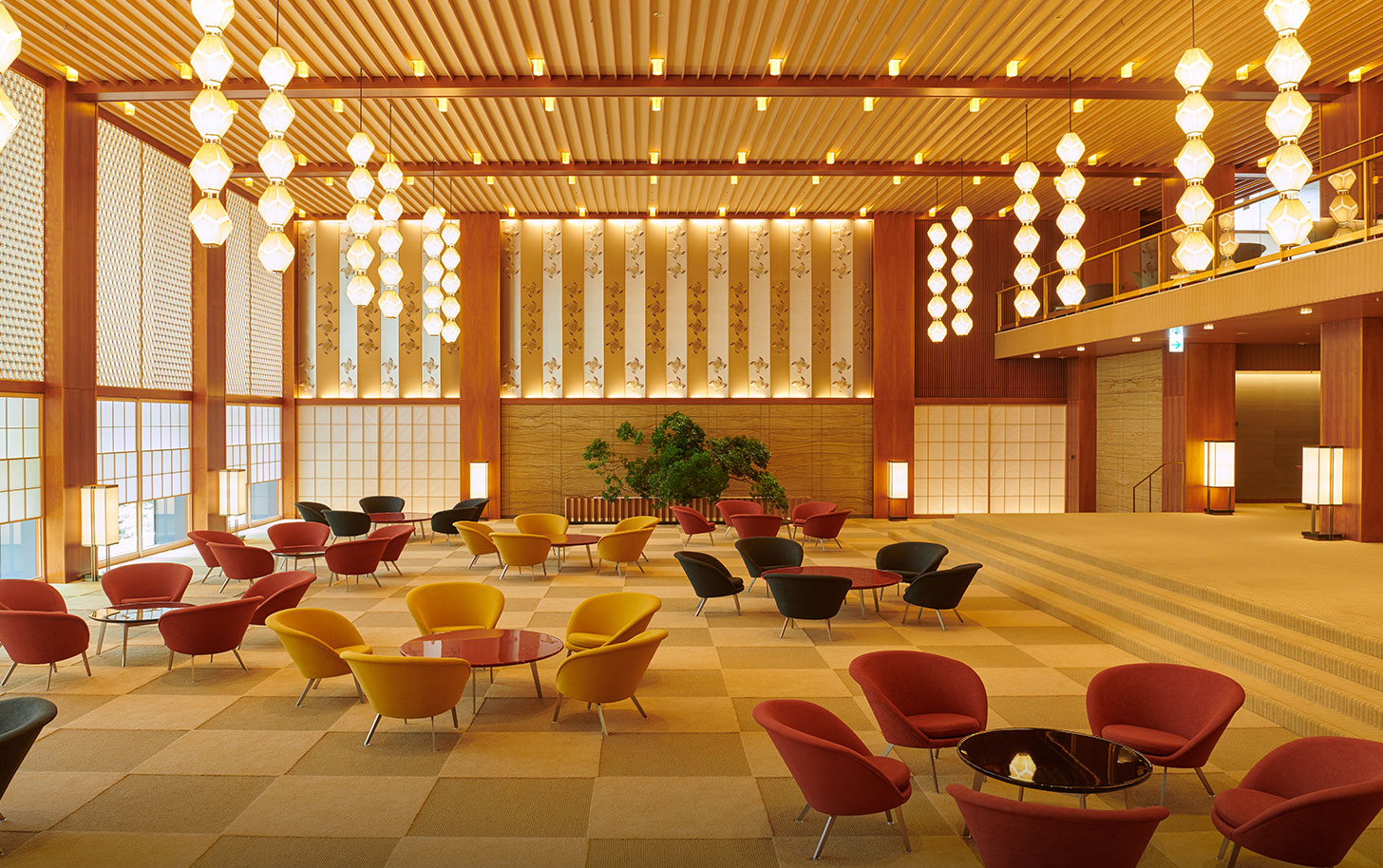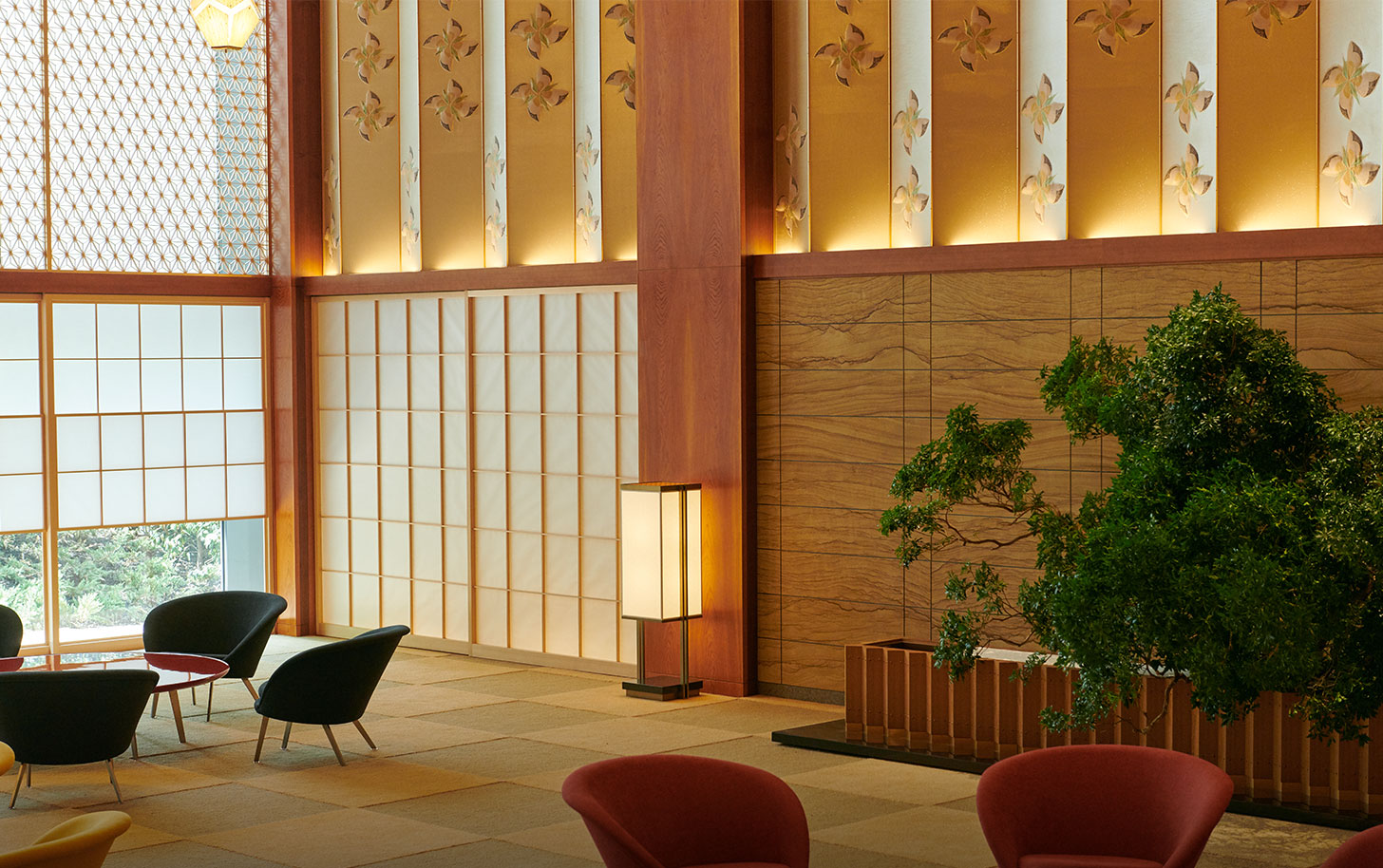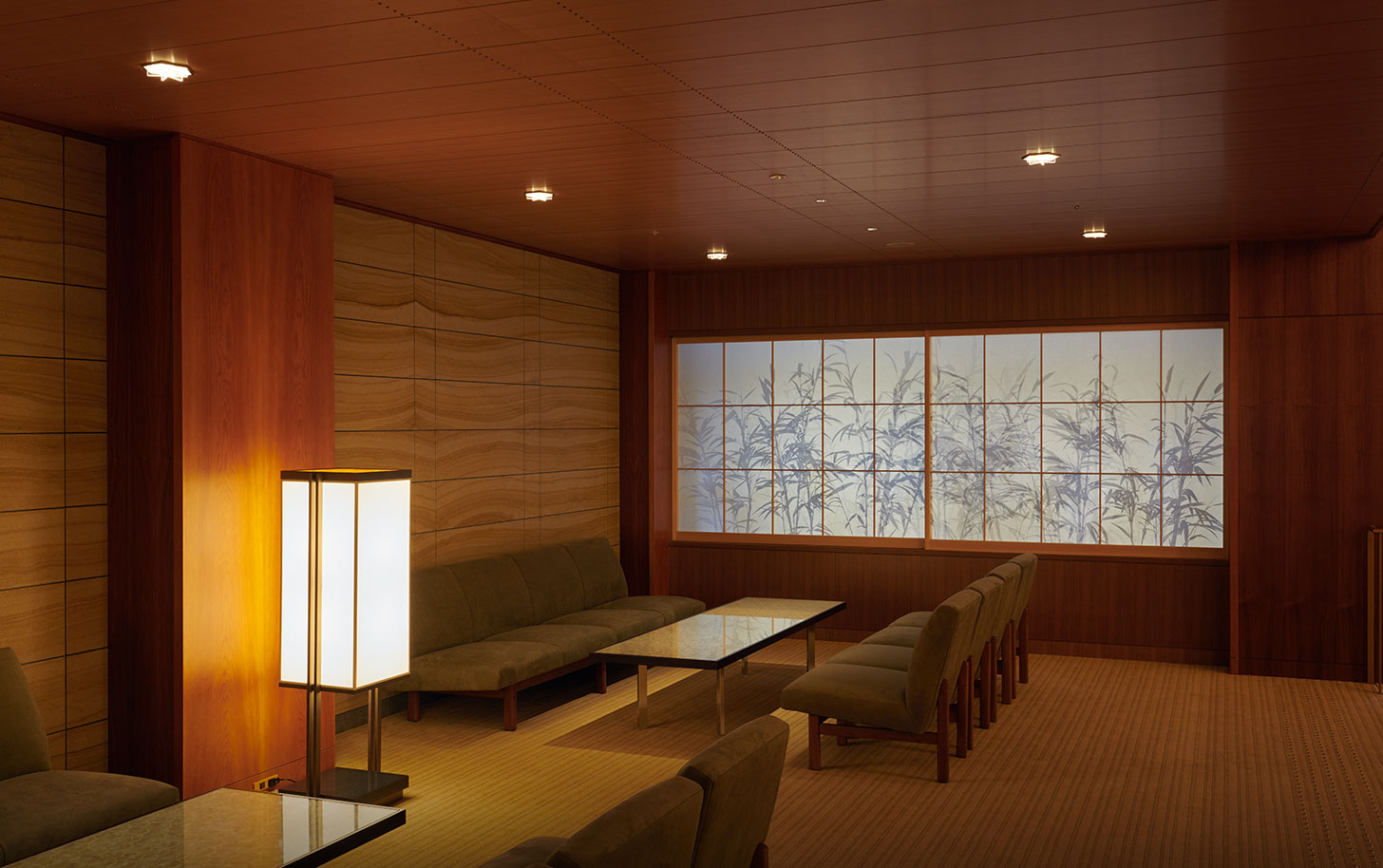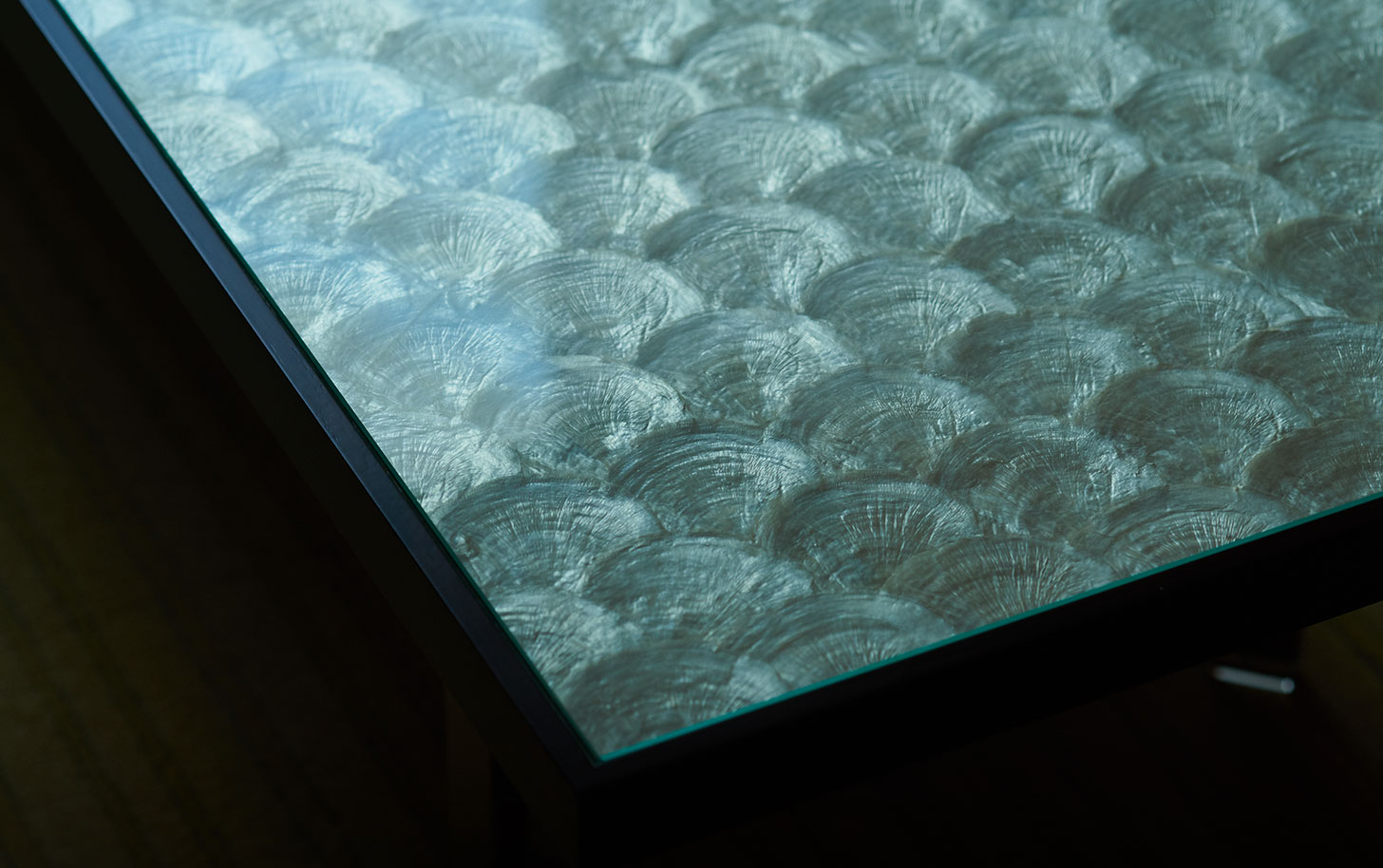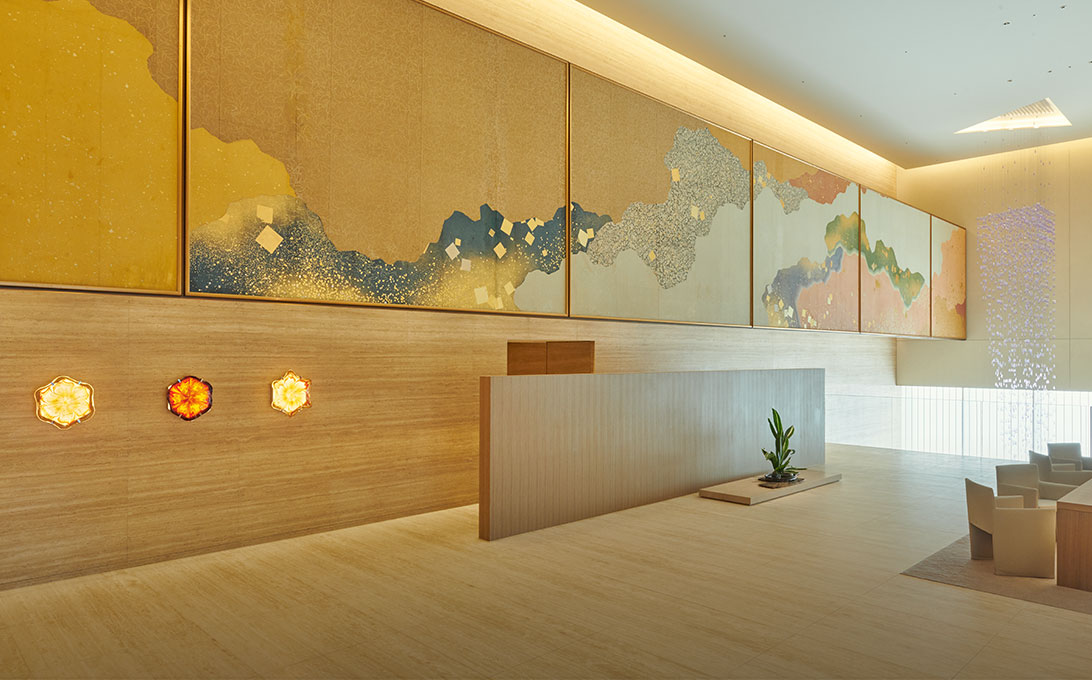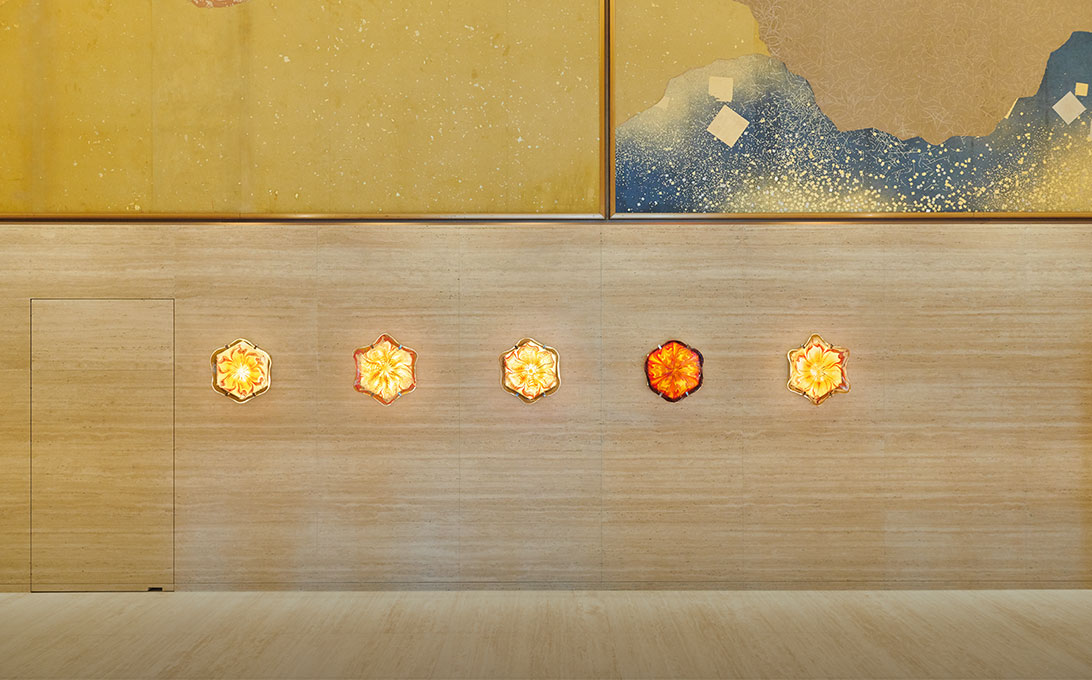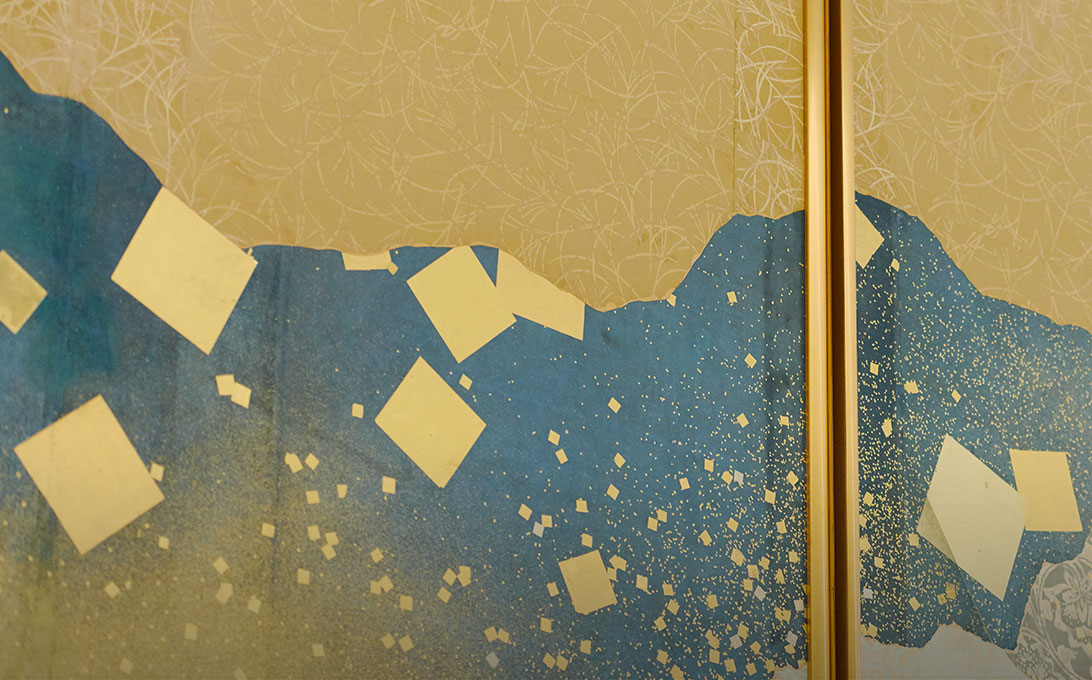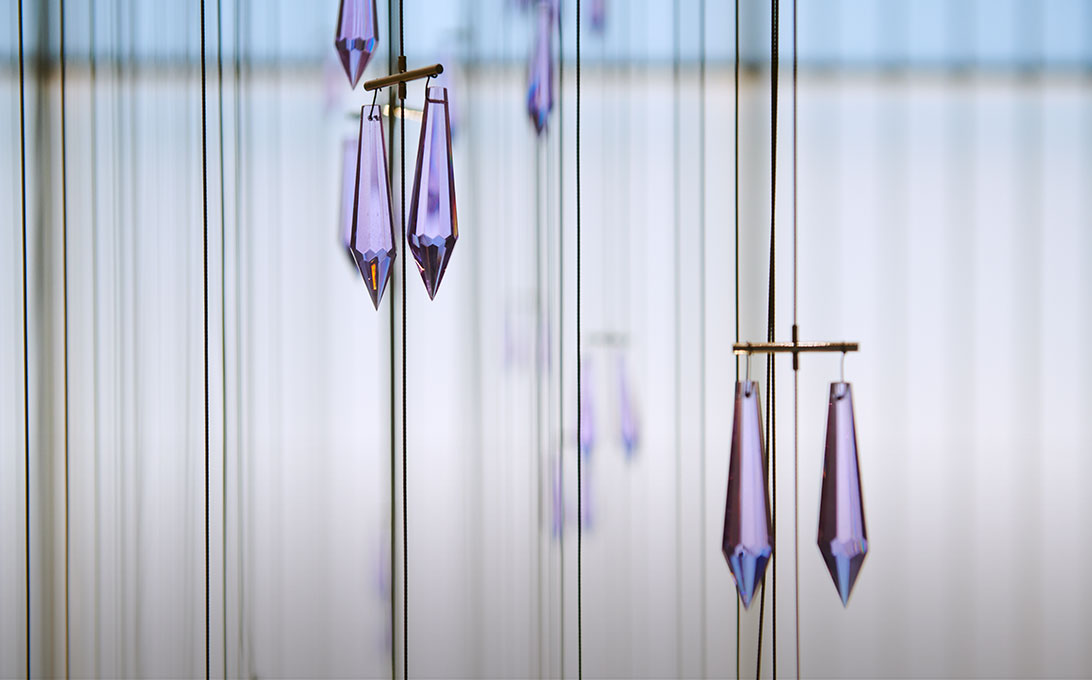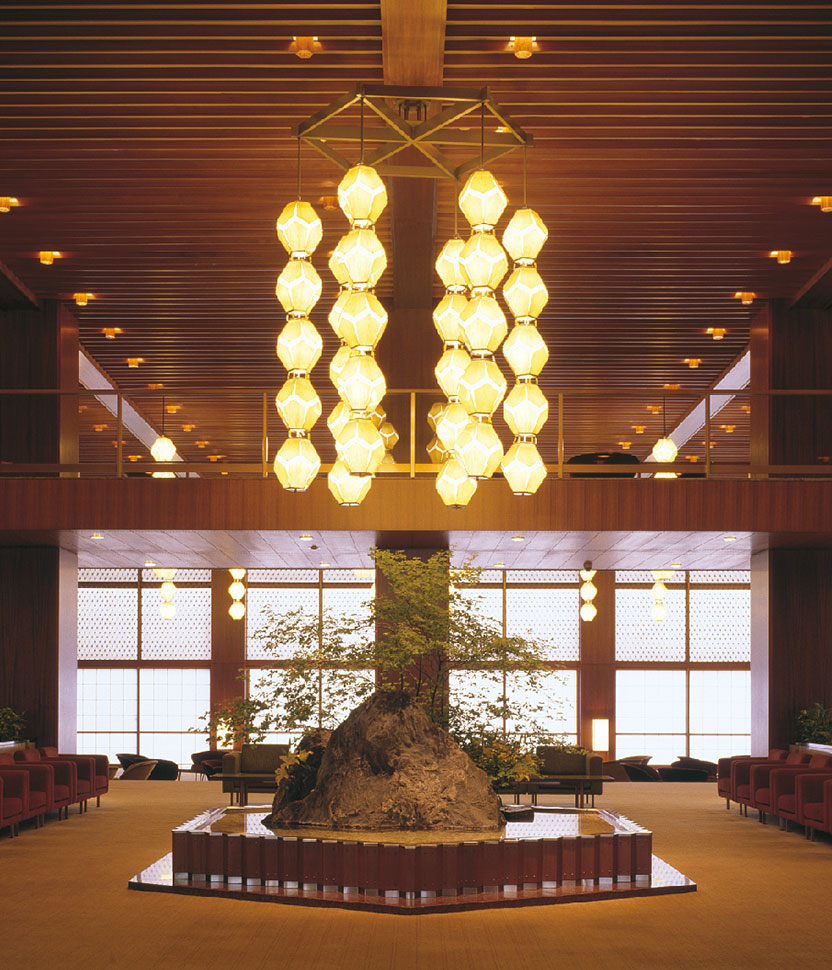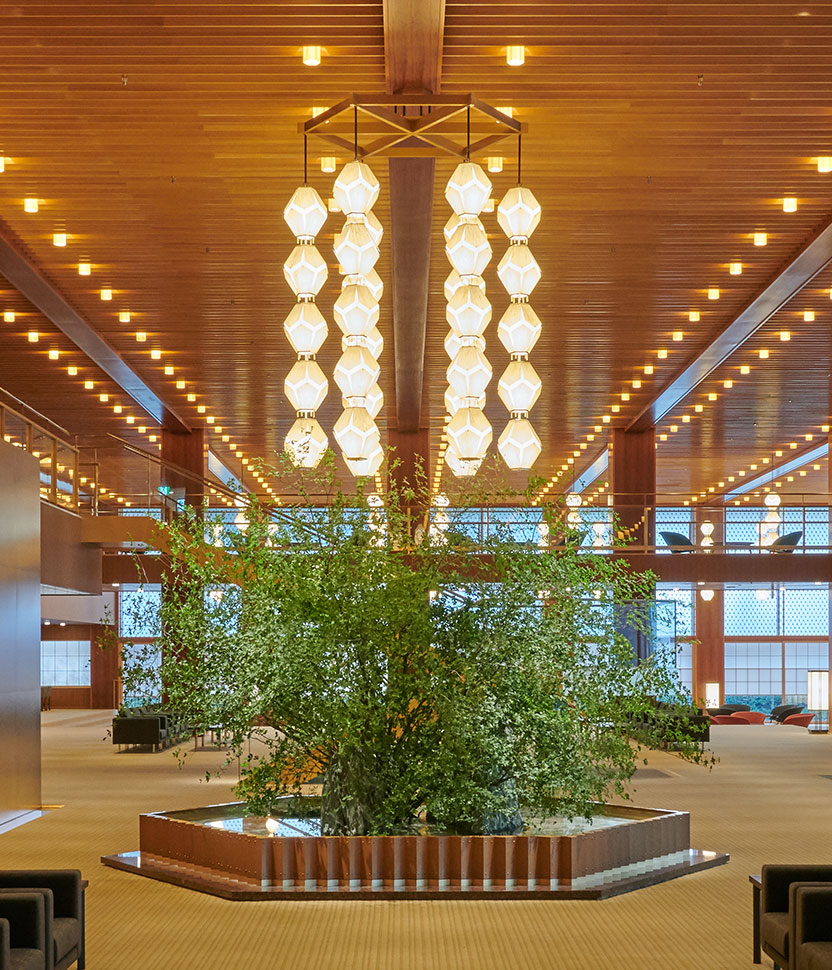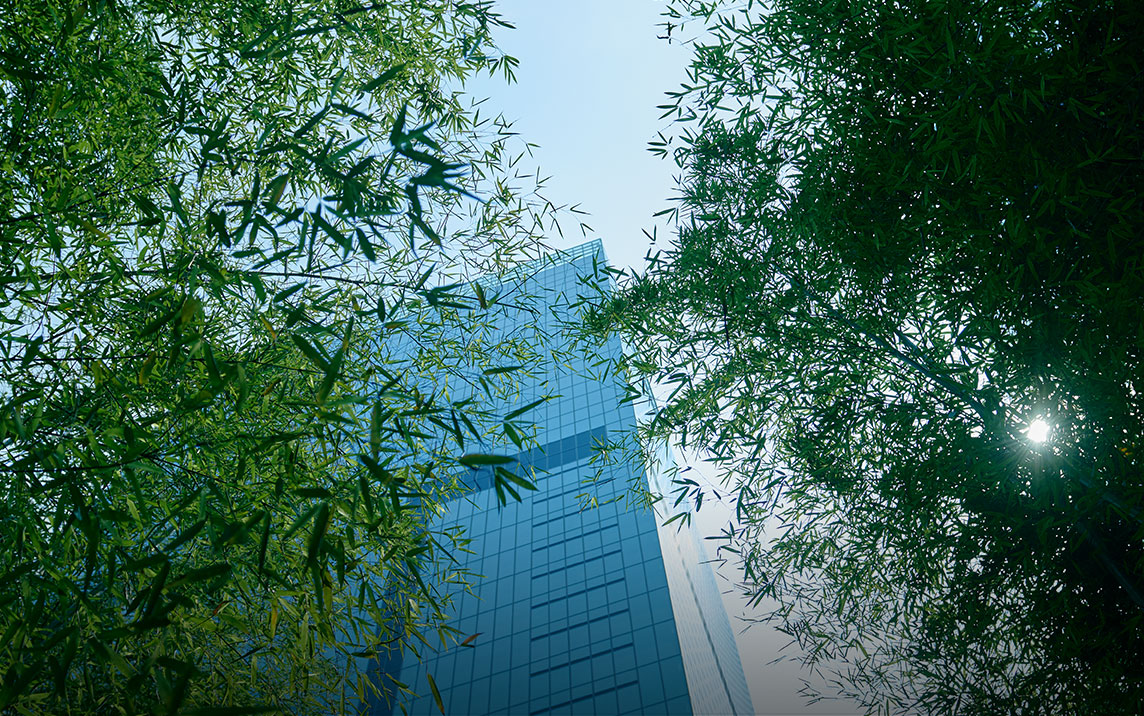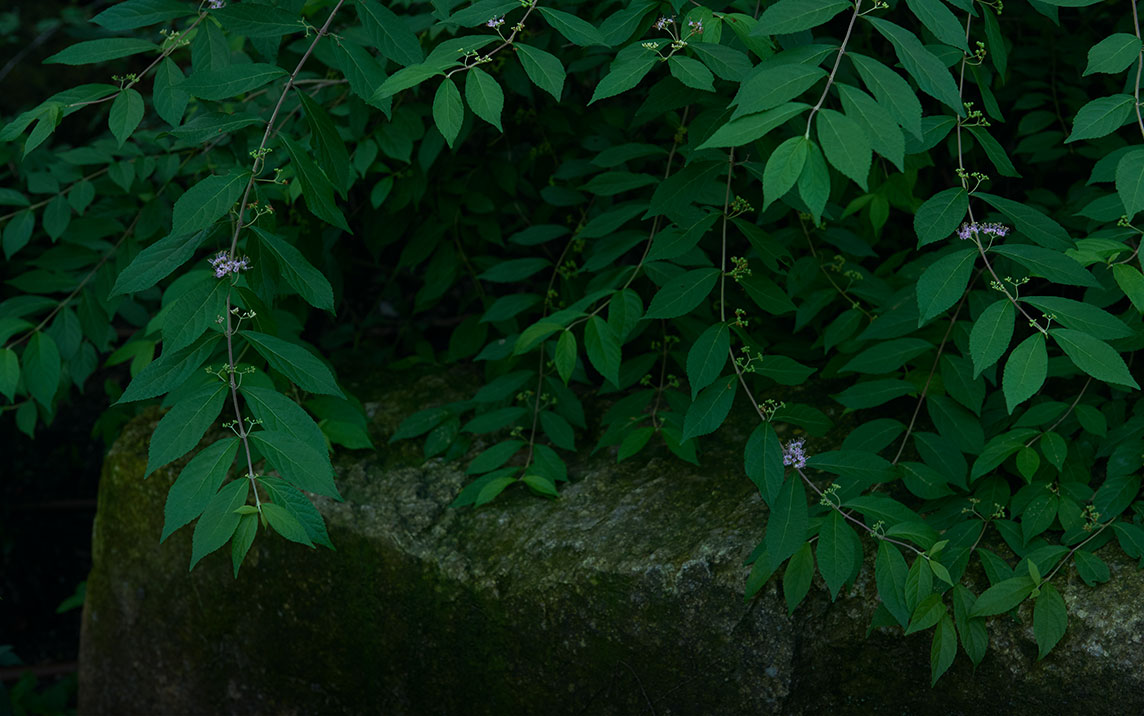Japanese Aesthetic
Tranquil Lobbies
Tranquil Lobbies
The Okura Tokyo has lobbies designed in the spirit of the original hotel’s aesthetic, both in the Okura Heritage Wing and the Okura Prestige Tower. Reminiscent of a Japanese tokonoma alcove, the Okura Heritage lobby has no ornamentation on the floor and ceiling. The front wall is decorated with a Japanese paper mural based on the motif from the scroll of the Heian Period poetry collection The Thirty-Six Immortals of Poetry. The mural is a section of a decorative wall moved from the Heian Room in the main building. The Okura Prestige Lobby is a faithful reproduction of the much-adored former main building lobby, with the latest technologies. Both new lobbies were designed by Yoshio Taniguchi, whose father, Yoshiro Taniguchi, designed the previous main building lobby.
Carrying on an Aesthetic Tradition
The original main building lobby was designed by Yoshiro Taniguchi, one of the 20th century’s leading Japanese architects. Taniguchi’s skillful application of a Japanese sensibility within the context of modernist architectural methods was in perfect accord with the hotel’s philosophy. Bringing the space he created back to life, the Okura Prestige Tower Lobby stands as evidence that the hotel’s founding philosophy lives on. The original lobby aimed above all for a tranquil and composed atmosphere. The new design revives the commodious lobby, dotted with plum flower motif tables and chairs.

Light and Shadow Design
The Okura Prestige Tower lobby features a design that beautifully balances light and shadow. The Okura Lanterns suspended from the ceiling are especially striking. Inspired by Kofun Period ornamental balls of crystal, the lanterns envelop light on a pendant of five polyhedrons. They have been newly equipped with LED and recreate the atmospheric lighting atmosphere in the original main lobby. One side of the room lets in soft natural light through a wall finished in oma-shoji (grid-pattern shoji) and kumiko traditional latticed woodwork. The new lobby faces a direction different from its predecessor, and allowing in light from the south. Lighting is subtly adjusted throughout the day in accord with the changes in natural light.

Appreciating the Wabi, Sabi and Miyabi Aesthetic
Appreciating the
Wabi, Sabi and
Miyabi Aesthetic
The Heian Room in the Hotel Okura main building became one of Japan’s most prestigious large ballrooms, the setting for numerous international conferences, appearances by celebrities, and other major events. The Okura Tokyo carries on that tradition with the new Heian Room. While the former Heian Room was decorated with a wall mural dedicated to The Thirty-Six Immortals of Poetry, a designated National Treasure, the new Heian Room features a wall mural with a motif based on the ornamental paper used for the Introduction to the Kokin Wakashu, an anthology of old and modern poems written in the Japanese poetic form known as waka, also a National Treasure, which is in the collection of the Okura Museum of Art. The designs were enlarged, made into woodblocks, and then hand-printed on handmade Japanese paper. The delicate color combinations and texture of the materials truly capture the essence of the Japanese aesthetic.
Bringing Japan’s Ancient
Aesthetic into the Design
The examples of Japanese beauty in The Okura Tokyo are not always immediately obvious. For example, the wall adorned with four-petal flowers in the Okura Prestige Tower Lobby was designed in his final year by ceramic artist and former Living National Treasure Kenkichi Tomimoto from his sickbed, at the request of Yoshiro Taniguchi, who designed the main building lobby. The pattern, based on the motif of Japan’s unique orchid, is a faithful reproduction of the original main building lobby’s Tatsumura art textile design, and has been newly woven to achieve a three-dimensional effect. The interior transom windows, illuminated hemp-leaf pattern, wisteria-motif chandeliers and other interior details provide glimpses of Japan’s ancient aesthetic.




An Urban
Tea Ceremony Room
An embodiment of the wabi-sabi aesthetic and Japanese antiquity, this tea room was completed two years after the Hotel Okura opened, on the 7th floor of the main building. It is named Chosho-an, which is a pseudonym for the hotel’s founder. The four-and-a-half tatami-mat space is a replica of the Yuin tea pavilion of the Urasenke school, a National Cultural Treasure. A masterpiece in the sukiya style, Chosho-an was built by the renowned master carpenter Sotoji Nakamura. At the Okura Tokyo, Chosho-an has been moved to the Okura Heritage Wing, to a spot right next to the Yamazato Japanese restaurant. This authentic tea room, which one least expects to find inside a modern building in the middle of the city, is sure to awaken an appreciation of the tea ceremony for guests from both Japan and abroad.
Modern Nature
Modern Nature
The Okura logo design is a combination of three gingko leaves. The building also includes many other pattern designs styled after the gingko leaf. The idea was conceived by Iwajiro Noda, the hotel’s president at the time of its initial opening. He was inspired by looking at a gingko tree on the hotel grounds from his office. Along with the gingko leaf, another frequently used variation is the hishi (traditional diamond-shape) pattern. The hishi pattern dates back to the 6th century and has taken a great variety of shapes. Gokaibishi (five overlapping hishi pattern) also forms the Okura family crest.
Elegant silverware
The Okura Tokyo’s restaurants and bars use some 500 varieties of silverware. These varieties include many with nature motifs. For example, some cutlery are engraved with the Mount Fuji mark and “1962”. The Mount Fuji mark is from 1962, when the Hotel Okura opened. In other words, cutlery from that time is still in use today. Likewise, large platters with grapevine reliefs are examples of the splendid technique of Japanese artisans. The silverware is silver-plated nickel-silver with a matte finish and remains in use thanks to meticulous maintenance.
Gardens for
Enjoying the
Four Seasons
The Okura Tokyo has gardens that enable guests to fully enjoy the flora of each passing season. The walking path begins at the Okura Square water pool, positioned as if enveloped by the Prestige Tower and the Heritage Wing. The garden features dynamic variations in ground levels, measuring 19 meters at its highest point, where stones have been arranged in a waterfall motif. There is also a pond full of iris and rabbitear iris, and a huge and historically significant gingko tree. All of these elements come together to compose a Japanese landscape that evokes the passing of the four seasons. Stone monuments and garden lanterns from the Okura Museum of Art collection are placed along some of the paths, adding an artistic touch.
Recreating a Scene of
Heian Period
Entertainment
Originally, the Hotel Okura had a dry landscape garden on the rooftop called Kyokusui Garden. The garden was inspired by kyokusui no utage, an elegant leisure entertainment during which Heian nobility composed tanka poems while drinking sake, as cups filled with sake floated by them in a stream. Taking Kyokusui Garden as a motif, the new garden is a place where visitors can feel the sensation of flowing water. Incorporating rock garden elements, the garden is filled with a variety of visual novelties, including a 12-ton stone.
The Okura way
A Love of the Arts
A Love of
the Arts
On the 25th of every month, the hotel sponsors a free concert in the Okura Prestige Tower lobby featuring classical music artists from Japan and overseas. Guests enjoy the sound of elegant music in a tranquil space while sipping a glass of sparkling wine. The lobby concerts began in 1987 as a commemoration of the hotel’s 25th year. Additionally, in 1996 the hotel established the Hotel Okura Music Award for up-and-coming musicians, and also sponsors a commemorative concert for the winners. The hotel’s founder, Kishichiro Okura, loved art and culture and strove to advance it. His passion for the arts was the original inspiration for these events.

A Love of
the Arts
On the 25th of every month, the hotel sponsors a free concert in the Okura Prestige Tower lobby featuring classical music artists from Japan and overseas. Guests enjoy the sound of elegant music in a tranquil space while sipping a glass of sparkling wine. The lobby concerts began in 1987 as a commemoration of the hotel’s 25th year. Additionally, in 1996 the hotel established the Hotel Okura Music Award for up-and-coming musicians, and also sponsors a commemorative concert for the winners. The hotel’s founder, Kishichiro Okura, loved art and culture and strove to advance it. His passion for the arts was the original inspiration for these events.
A Place to Share Culture
The Okura Tokyo believes that a hotel is not just a place for accommodations and dining, but for people to come together to share culture. For example, in 1973 the hotel’s fitness and spa facility became the first hotel health club in Japan to set up a membership system. The health club was notable for its personal trainers and focus on the overall health of its members. Additionally, the hotel’s go salon, which opened in 1982, features instruction of members by a female master of the Japanese board game. At one time, go was a favorite of aristocratic society, and Kishichiro Okura’s support of the Japan Go Association led to the game becoming a valued cultural activity at The Okura Hotel. The newly opened hotel intends to continue supporting go.

Wine Appreciation Courses
The Okura Tokyo Wine Academy offers a variety of courses aimed at different levels and objectives. Experienced sommeliers from the hotel’s restaurants, experts on various aspects of wine and famous critics hone students’ knowledge through lectures and a unique curriculum. The Okura Tokyo boasts a rich variety of wines kept in its well-tended cave area, including rare wine. Only those wines which best fit each class’ particular theme are selected. For the greatest enjoyment, the proper pairing of food and wine is essential. At every session, students enjoy the best pairings, whether with French, Japanese or Chinese cuisine, or cheese.

Art at the Okura Tokyo
Art at the
Okura Tokyo
The Okura Tokyo grounds include a striking building in the style of classical Chinese architecture. It is home to the Okura Museum of Art. The museum opened in 1917 and remains as Japan’s existing oldest private art museum. Okura conglomerate founder Kihachiro Okura was an avid collector of Japanese and East Asian antiques. When the Okura Museum of Art became a foundation and opened to the public, it enabled many people to encounter great works of Asian art, which was completely unheard of at the time. When The Okura Hotel opened, the museum building was moved 6.5 meters from its original location and the storage rooms around its perimeter were removed. The refurbished museum then reopened at its present location.

Art at the
Okura Tokyo
The Okura Tokyo grounds include a striking building in the style of classical Chinese architecture. It is home to the Okura Museum of Art. The museum opened in 1917 and remains as Japan’s existing oldest private art museum. Okura conglomerate founder Kihachiro Okura was an avid collector of Japanese and East Asian antiques. When the Okura Museum of Art became a foundation and opened to the public, it enabled many people to encounter great works of Asian art, which was completely unheard of at the time. When The Okura Hotel opened, the museum building was moved 6.5 meters from its original location and the storage rooms around its perimeter were removed. The refurbished museum then reopened at its present location.
A Collection of Art Treasures
The Okura Museum of Art collection comprises some 2,500 works, including three National Treasures, a copy of the Introduction to the Kokin Wakashu among them, 13 Important Cultural Properties, and 44 Art Treasures. To prevent the loss of great art in Japan and neighboring countries, Kihachiro Okura collected a great variety of paintings, sculptures, calligraphy, handicrafts and other pieces of art. His son, the Hotel Okura founder Kishichiro Okura, donated Japanese modern paintings to the museum and actively supported its activities. The museum is known for its extensive collection of items that radiate grace and refinement. The sensibility expressed by these works is fundamentally connected to the hotel’s own aesthetic.
Hotel As Art Museum
The precious art on display at the Okura Tokyo includes other pieces besides those which belong to the Okura Museum of Art. Creating vibrant spaces that highlight great art has been an ongoing activity since the Hotel Okura era. The Okura Tokyo is unique for treating its entire environment as a work of art, from the architecture to the interior furnishings. Instead, wallpaper has been selected based on its artistic merit.




Signature Menus
Signature Menus
Each restaurant and bar at the Okura Tokyo features a Signature Menu. Many of these dishes have been served for generations, such as the simmered sea bream (Tai no Aradaki) at the Yamazato Japanese restaurant. In order to serve only the heads of the most tasty wild-caught red sea bream, for example, selecting ingredients requires the utmost discernment, including changing regions where the fish are caught depending on the season. People have their favorite Japanese seasonings, so rather than a particular “Yamazato” seasoning, the fish is prepared for each occasion according to the customer’s preferences. This dedication to the finest quality has been handed down since the hotel first opened.

Signature Menus
Each restaurant and bar at the Okura Tokyo features a Signature Menu. Many of these dishes have been served for generations, such as the simmered sea bream (Tai no Aradaki) at the Yamazato Japanese restaurant. In order to serve only the heads of the most tasty wild-caught red sea bream, for example, selecting ingredients requires the utmost discernment, including changing regions where the fish are caught depending on the season. People have their favorite Japanese seasonings, so rather than a particular “Yamazato” seasoning, the fish is prepared for each occasion according to the customer’s preferences. This dedication to the finest quality has been handed down since the hotel first opened.
Our Specialty: Excellent Sliced Wagyu Beef Rib with Sauce
A thin-sliced select beef rib with shiso perilla, fine strips of leek and roasted garlic slices rolled inside is quickly grilled and served with sauce and finely grated radish. This is Teppanyaki Sazanka’s signature dish, Excellent Sliced Wagyu Beef Rib with Sauce. A dish served by popular demand, unlike the thick sirloin that is the main attraction of teppanyaki-style cooking, the beef is thinly sliced to bring out the greatest flavor, and delicately grilled to a tender, juicy finish. This is done at the table, using only the finest ingredients. One of the reasons why teppanyaki has become such a popular style of Japanese cuisine worldwide is the Okura’s ingenuity and effort in enhancing it.

Martini
Known as the king of cocktails, the martini is a signature drink at the Orchid Bar, which has been a part of the hotel since it opened. This is a very dry martini with just a pinch of the bar’s original blend of Noilly Prat and orange bitters. To avoid a watery finish when blending the drink and ice in the mixing glass, ice resistance is kept to a minimum by stirring with a special technique, an Okura specialty.
One of the attractions is that there are many variations. We offer a precious cup of espresso martini with the image of an orchid, fruit martini using seasonal fruits such as kumquat and strawberry.

